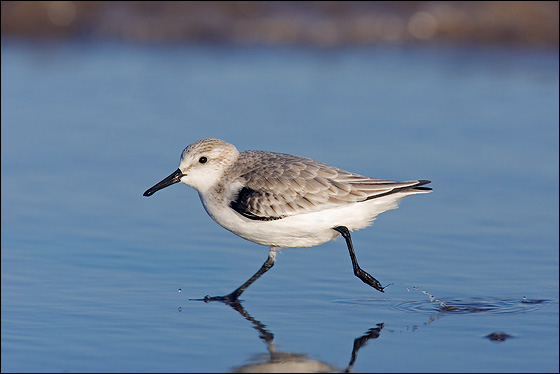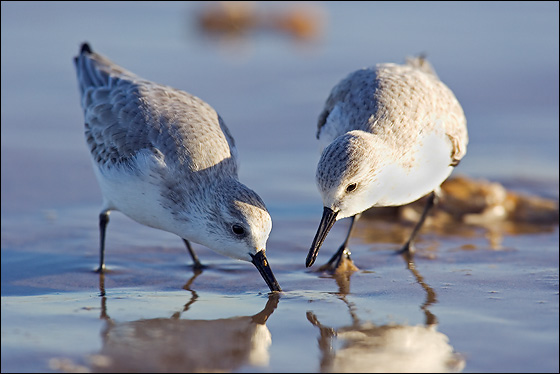Sanderling (Calidris alba)
Watching a Sanderling feeding can be exhausting. Its main technique is to pick small prey items from the shallow water of retreating waves. That demands a great deal of dashing about along beaches, in and out with the breakers, with legs moving as fast as clockwork to avoid being swamped by the fast-moving water. It looks hard work, but this method of foraging isolates the Sanderling in the non-breeding season from the heavy competition among waders in the softer, humdrum muddy intertidal zone of estuaries. So flocks of feeding Sanderlings normally have the beach virtually to themselves.
The Sanderling has a clear physical adaptation to its lifestyle of fast running. It lacks a hind toe, a modification to cut down drag on the hard ground as it moves forward; it is the only wader so designed. The Sanderling also has an extremely sensitive bill to help it find prey concealed in the sand. The touch receptors at the tip are so efficient that they can detect the vibrations of worms 2cm away; they don’t actually have to touch something at all to know it is there. Apart from worms the bill also picks up tiny crabs, shrimps and sandhoppers, among other items.
Away from its more familiar winter haunts the Sanderling is one of the extreme Arctic nesters among waders, breeding way north of any other species except the Knot. Even the northernmost parts of Scandinavia are too warm for it; it prefers the Arctic islands almost hugging the polar ice-cap. In this forbidding zone it selects a dry, open site on the chilly tundra, never far from water, usually on the coast. Its only shelter comes from sparse low-growing vegetation.
The Sanderling has a clear physical adaptation to its lifestyle of fast running. It lacks a hind toe, a modification to cut down drag on the hard ground as it moves forward; it is the only wader so designed. The Sanderling also has an extremely sensitive bill to help it find prey concealed in the sand. The touch receptors at the tip are so efficient that they can detect the vibrations of worms 2cm away; they don’t actually have to touch something at all to know it is there. Apart from worms the bill also picks up tiny crabs, shrimps and sandhoppers, among other items.
Away from its more familiar winter haunts the Sanderling is one of the extreme Arctic nesters among waders, breeding way north of any other species except the Knot. Even the northernmost parts of Scandinavia are too warm for it; it prefers the Arctic islands almost hugging the polar ice-cap. In this forbidding zone it selects a dry, open site on the chilly tundra, never far from water, usually on the coast. Its only shelter comes from sparse low-growing vegetation.
Many Sanderling pairs are monogamous, but with such a short breeding season available, some ambitious females resort to laying more than one clutch and delegating each to a separate male to incubate and look after the subsequent chicks. Alternatively a female may lay two clutches of eggs and incubate one herself, with her mate sitting on the other.


